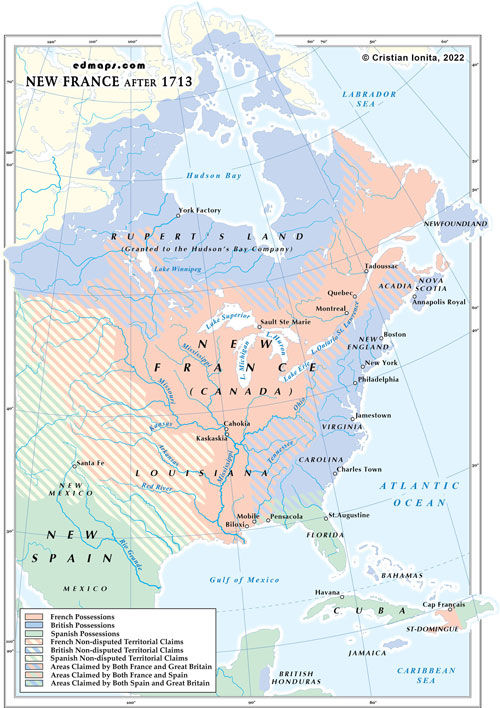New France after 1713


New France after the Treaty of Utrecht (1713)
After 1713, New France, the French colonial territory in North America, experienced a period of growth, conflict, and expansion. Here are some key events and developments during this period:
Consolidation of Territories: After the Treaty of Utrecht in 1713, which resulted in the loss of Newfoundland, Acadia, and Hudson Bay to the British, New France focused on consolidating its remaining territories. The French administration sought to strengthen its control over Quebec and the St. Lawrence River Valley, establishing it as the heart of New France.
Fortification of Quebec City: In order to protect its key stronghold, the French significantly fortified Quebec City. Under the direction of military engineer Gaspard-Joseph Chaussegros de Léry, extensive fortifications, including ramparts and citadels, were constructed to defend against potential British attacks. These fortifications would play a crucial role in the defense of Quebec during the subsequent conflicts.
Expansion into the Interior: French explorers and traders continued to expand their presence into the interior of North America during this period. French fur traders and coureurs des bois ventured further westward, establishing trade networks with Indigenous peoples and solidifying French influence in the fur trade economy. The French maintained a strong presence in the Great Lakes region, building alliances with Indigenous nations such as the Huron, Ottawa, and Ojibwe.
King George's War (1744-1748): This conflict, known as the War of Austrian Succession in Europe, spilled over into North America and had implications for New France. The war saw France and Britain once again pitted against each other. In North America, the French and their Indigenous allies launched attacks on British colonies, particularly in Acadia and present-day Maine. However, the British were able to capture the French fortress of Louisbourg on Cape Breton Island in 1745, temporarily disrupting French control in the region.
The Treaty of Aix-la-Chapelle (1748): The Treaty of Aix-la-Chapelle ended King George's War and restored Louisbourg to French control, returning the situation in North America to the status quo ante bellum. This peace settlement demonstrated the ongoing contestation between France and Britain for control over North American territories.
Overall, between 1713 and 1745, New France worked to consolidate its remaining territories, expand its influence into the interior, and fortify key locations such as Quebec City. However, conflicts with the British, as well as ongoing challenges in governing the vast territory, foreshadowed the further struggles that would define New France's later history.








